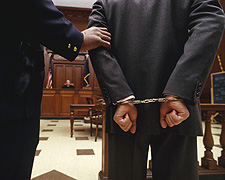| Aikens v. California | |
|---|---|
| Argued January 17, 1972 Decided June 7, 1972 | |
| Full case name | Earnest James Aikens, Jr. v. People of the State of California |
| Citations | 92 S. Ct. 1931; 32 L. Ed. 2d 511; 1972 U.S. LEXIS 52 |
| Prior history | Crim. No. 10118 February 18, 1969: 70 Cal. 2d 369, 450 P.2d 258; Certiorari dismissed (406 U.S. 813) |
| Subsequent history | Death sentence converted to Life in Prison |
| Holding | |
| Since petitioner no longer faces execution, his appeal is moot. | |
| Court membership | |
| |
| Case opinions | |
| Per curiam. | |
Aikens v. California, 406 U.S. 813 (1972), [1] was a decision of the United States Supreme Court where a petitioner (in the U.S. Supreme Court, the plaintiff (Aikens) is called the petitioner and the defendant (the State of California) is called the respondent) was appealing his conviction and death sentence. After oral argument had been made on the case, but before the court decided on it, the Supreme Court of California in People v. Anderson , [2] declared the death penalty unconstitutional under the state constitution. This made his appeal unnecessary because the decision in Anderson

The Supreme Court of the United States is the highest court in the federal judiciary of the United States. Established pursuant to Article III of the U.S. Constitution in 1789, it has original jurisdiction over a small range of cases, such as suits between two or more states, and those involving ambassadors. It also has ultimate appellate jurisdiction over all federal court and state court cases that involve a point of federal constitutional or statutory law. The Court has the power of judicial review, the ability to invalidate a statute for violating a provision of the Constitution or an executive act for being unlawful. However, it may act only within the context of a case in an area of law over which it has jurisdiction. The Court may decide cases having political overtones, but it has ruled that it does not have power to decide nonjusticiable political questions. Each year it agrees to hear about 100–150 of the more than 7,000 cases that it is asked to review.
A plaintiff is the party who initiates a lawsuit before a court. By doing so, the plaintiff seeks a legal remedy; if this search is successful, the court will issue judgment in favor of the plaintiff and make the appropriate court order. "Plaintiff" is the term used in civil cases in most English-speaking jurisdictions, the notable exception being England and Wales, where a plaintiff has, since the introduction of the Civil Procedure Rules in 1999, been known as a "claimant", but that term also has other meanings. In criminal cases, the prosecutor brings the case against the defendant, but the key complaining party is often called the "complainant".

A defendant is a person accused of committing a crime in criminal prosecution or a person against whom some type of civil relief is being sought in a civil case.
Contents
declared capital punishment in California unconstitutional under Art. 1, 6, of the state constitution... The California Supreme Court declared in the Anderson case that its decision was fully retroactive and stated that any prisoner currently under sentence of death could petition a superior court to modify its judgment. [Aikens] thus no longer faces a realistic threat of execution... [emphasis added]
The Supreme Court would decide later that year, in Furman v. Georgia , [3] that the Death Penalty was under certain circumstances unconstitutional. Aikens was originally one of four cases that were selected along with Furman, but when the Anderson case was decided by the California Supreme Court, Aikens became moot.
Furman v. Georgia, 408 U.S. 238 (1972), was a criminal case in which the United States Supreme Court struck down all death penalty schemes in the United States in a 5–4 decision, with each member of the majority writing a separate opinion. Following Furman, in order to reinstate the death penalty, states had to at least remove arbitrary and discriminatory effects, to satisfy the Eighth Amendment to the United States Constitution.

In law, the terms moot and mootness have different meanings in British English and American English. The concept is important in U.S. jurisprudence but is little used elsewhere outside law schools.





